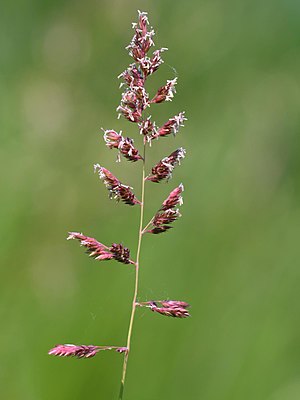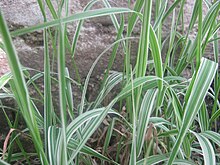Reed grass
| Reed grass | ||||||||||||
|---|---|---|---|---|---|---|---|---|---|---|---|---|

Reed grass ( Phalaris arundinacea ) |
||||||||||||
| Systematics | ||||||||||||
|
||||||||||||
| Scientific name | ||||||||||||
| Phalaris arundinacea | ||||||||||||
| L. |
Reed grass ( Phalaris arundinacea L.), also called Havelmielitz or Havelmilitz , is a reed- like, but much smaller plant species from the sweet grass family .
description
Vegetative characteristics
The reed grass reaches a height of 0.5 to 2.0 m and has a fleshy root system with underground runners.
The youngest sheet is usually rolled. The sturdy leaf blades of the older leaves are over 15 mm wide, ungreased and glabrous. They have more or less distinct cross veins. The leaf base is without auricles and has a dirty white, large ligule that is pulled up into a point (in contrast to the reed hairline). The leaf sheaths are open, glabrous and have clear cross veins.
Generative characteristics
The flowers of the reed grass are 10 to 20 cm long, real panicles on all sides. The panicle is spread during flowering, but otherwise contracted. There are always two branches on the lowest spindle step. Reed and riding grass here have several branches and the common crook grass only one branch. The unburned, single-flowered and lanceolate spikelets of the reed grass are clustered together in clusters. Each spikelet has four keeled glumes. The lemmas are shiny.
The flowering period extends from June to July.
The number of chromosomes is 2n = 28, less often 14.
ecology
The reed grass is a soil stabilizer and a change in moisture indicator. It is a root creeping pioneer and roots up to 3.5 meters deep.
The flowers are wind-blooming of the "long-dust filament type".
Propagation units are surrounded by the top and palea caryopses ; they spread as balloon flyers; in addition, it spreads randomly through grazing animals and, because of the air under the husks, also spreads by swimming.
Vegetative reproduction takes place abundantly due to the long underground foothills . This often results in large stands that come from a single plant.
Occurrence
The reed grass is native to the temperate latitudes of Europe , Asia and North America , but hardly goes above heights of 1500 m . In the Allgäu Alps in Vorarlberg between Untergehren and Warth it rises up to 1400 meters above sea level. It often grows in large groups on or in flowing, oxygen-rich waters, but does not tolerate stagnant water. The reed grass prefers strong locations and therefore particularly nutrient-rich clay and mud soils ( alluvial forest soils ). Occasionally it also occurs on dry sites, but these must not be compacted, too low in nutrients or too rich in raw humus ( acidic ). It is a light-loving, but also partial shade-enduring kind . It is a character species of the Phalaridetum arundinaceae from the Magnocaricion association, but also occurs in societies of the Phragmitetalia order or the Alno-Ulmion association.
Cultivars
Cultivars of reed cane were bred for deep, moist locations. As a mass-growing hay grass, it is very productive, but only forms a relatively coarse forage, formerly known as horse hay. Reed grass has an early cut maturity.
Reed grass has been cultivated as an ornamental plant in the white-striped garden shape 'Picta' since around 1600 .
Reed canary grass is Gramin -containing. Because of the harmful effects that gramin has on grazing farm animals such as B. Sheep have grown low-gramin cultivars over the past several decades. Contrary to popular belief, dimethyltryptamine (DMT) is not responsible for grazing animals to die.
Energy plant
Reed cane grass is considered an energy crop with a high biomass yield. As a briquette or pellet , it can be used for climate-friendly combustion.
literature
- Rudolf Schubert , Klaus Werner, Hermann Meusel (eds.): Excursion flora for the areas of the GDR and the FRG . Founded by Werner Rothmaler. 13th edition. tape 2 : vascular plants . People and knowledge, Berlin 1987, ISBN 3-06-012539-2 .
- Herbert Hesmer , Jürgen Meyer: Forest grasses. 2nd Edition. M. u. H. Schaper, Hanover 1950.
- K. Dörters: Sweet grasses, sedge and rush plants. 2nd Edition. Urania-Verlag , Leipzig / Jena / Berlin 1977.
- J. Krejča: From our nature (plants). 1st edition. Deutscher Landwirtschaftsverlag, Berlin 1978 (now ISBN 3-570-09856-7 ).
- Fritz Encke, Günther Buchheim, Siegmund Seybold: Concise dictionary of plant names. Founded by Robert Zander . 12th edition. Deutscher Landwirtschaftsverlag, Berlin 1981 (corresponds to Eugen Ulmer, Stuttgart 1980, ISBN 3-8001-5017-4 ).
Web links
- Reed grass. In: FloraWeb.de.
- Reed grass . In: BiolFlor, the database of biological-ecological characteristics of the flora of Germany.
- Profile and distribution map for Bavaria . In: Botanical Information Hub of Bavaria .
- Phalaris arundinacea L. In: Info Flora , the national data and information center for Swiss flora .
- Distribution in the northern hemisphere from: Eric Hultén, Magnus Fries: Atlas of North European vascular plants. 1986, ISBN 3-87429-263-0 at Den virtuella floran. (Swedish)
- Thomas Meyer: Data sheet with identification key and photos at Flora-de: Flora von Deutschland (old name of the website: Flowers in Swabia )
- Michael Pankratius Lexicon Renewable Resources
- Drawing of a reed grass plant
Individual evidence
- ↑ a b c Erich Oberdorfer : Plant-sociological excursion flora for Germany and neighboring areas . 8th edition. Verlag Eugen Ulmer, Stuttgart 2001, ISBN 3-8001-3131-5 . Page 263–264.
- ↑ a b c Ruprecht Düll , Herfried Kutzelnigg : Pocket dictionary of plants in Germany and neighboring countries. The most common Central European species in portrait . 7th, corrected and enlarged edition. Quelle & Meyer, Wiebelsheim 2011, ISBN 978-3-494-01424-1 .
- ↑ Erhard Dörr, Wolfgang Lippert : Flora of the Allgäu and its surroundings. Volume 1, IHW, Eching 2001, ISBN 3-930167-50-6 , p. 150.
- ↑ Phalaris arundinacea in the Lexicon of Medicinal Plants and Drugs , accessed on July 7, 2014.
- ↑ GL Marten, RM Jordan, AW Hovin: Biological significance of reed canarygrass alkaloids and association with palatability variation to grazing in sheep and cattle. In: Agronomy Journal . Volume 68, 1976, pp. 909-914.
- ↑ a b Michael Pankratius . The Future of the Field, Retrieved April 6, 2010.


